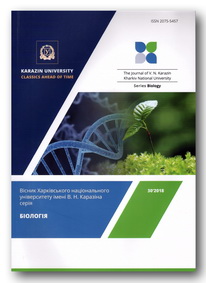Effect of low temperature storage conditions on the viability of microalgae Chlorococcum dissectum
Abstract
Chlorococcum dissectum Korshikov, 1953 is a unicellular freshwater green alga capable of accumulating and depositing lipids in cells. Regardless of their origin and taxonomic classification, biotechnologically important microorganisms and cell lines are biological resources that are used to produce various products. The aim of the work was to determine the effect of low-temperature storage conditions on the alga viability. The temperatures used were as follows: –18, –40, –70, and –196°C. An ordinary household freezer was used to provide –18°C. Cooling to –40 and –70°C was carried out with uncontrolled cooling rates by placing the cryotubes directly into the freezers or using a Mr. Frosty freezing container, which provides a temperature decrease rate of 1 deg/min. Freezing to –196°C was carried out by direct immersion of cryotubes in liquid nitrogen and two-stage cooling at 1 and 20 deg/min to –40°C with subsequent transfer to a cryostorage. The viability of C. dissectum was determined by counting the colonies formed on BG-11 agarized nutrient medium. It was found that the cells completely lost their viability after freezing to –18°C and storage for two days. Cryopreservation to –196°C for all studied variants and uncontrolled cooling rate to –40 and –70°C, as well as further storage of such samples at these temperatures, led to significant or complete loss of their viability. Cooling in a Mr. Frosty freezer container to –40 and –70°C did not affect the ability of cells to grow. Moreover, storing C. dissectum at –40°C did not cause a significant loss of viability throughout the study period, and its storage at –70°C did not change the viability index at all. The obtained results showed that the controlled cooling and the use of freezers at –40°C and –70°C, respectively, are promising for medium-term and long-term storage of C. dissectum suspension culture. To increase the viability of samples after cooling to liquid nitrogen temperature, it is necessary to develop cryopreservation modes using cryoprotectants.
Downloads
References
Abreu L., Borges L., Marangoni J., Abreu P.C. (2012). Cryopreservation of some useful microalgae species for biotechnological exploitation. Journal of Applied Phycology, 24(6), 1579–1588. https://doi.org/10.1007/s10811-012-9818-0
Al-Rikabey M.N., Al-Mayah A.M. (2018). Cultivation of Chlorella vulgaris in BG-11 media using Taguchi method. Jour. of Adv. Research in Dynamical & Control System, 10(7), 19–30.
Ananyina G.E., Stepanyuk L.V., Visekantsev I.P., Petrov I.V. (2020). Influence of hypothermic and low-temperature storage conditions on the viability of immobilized probiotic Bifidobacterium bifidum. Actual problems of modern medicine: Bulletin of the Ukrainian Medical Stomatological Academy, 3(71),185–191. (In Ukrainian)
Aravantinou A.F., Manariotis I.D. (2016). Effect of operating conditions on Chlorococcum sp. growth and lipid production. Journal of Environmental Chemical Engineering, 4(1), 1217–1223. https://doi.org/10.1016/j.jece.2016.01.028
Bui T.V.L., Ross I.L., Jakob G., Hankamer B. (2013). Impact of procedural steps and cryopreservation agents in the cryopreservation of chlorophyte microalgae. PloS one, 8(11), e78668. https://doi.org/10.1371/journal.pone.0078668
Charrier B., Wichard T., Reddy C.R.K. (Eds.). (2018). Protocols for macroalgae research. CRC Press. 518 p. https://doi.org/10.1201/b21460
Chernobai N.A., Vozovik K.D., Kadnikova N.G. (2021). Comparative analysis of methods for assessing the preservation of microalgae cultures of Dunaliella salina Teodoresco and Chlorococcum dissectum Korshikov (Chlorophyta) after exposure to stress factors, Algologia, 31(4), 353–364. https://doi.org/10.15407/alg31.04.353 (In Ukrainian)
Day J.G., Fleck R.A. (2015). Cryo-injury in algae and the implications this has to the conservation of micro-algae. Microalgae Biotechnol, 1(1), 1–11. https://doi.org/10.1515/micbi-2015-0001
Day J.G., Harding K. (2008). Cryopreservation of algae. Plant cryopreservation: a practical guide. Springer, New York, NY. 95–116. https://doi.org/10.1007/978-0-387-72276-4_6
Day J.G., Brand J.J. (2005). Cryopreservation methods for maintaining microalgal cultures. Algal Culturing Techniques. Academic Press, Elsevier. 165–187. http://dx.doi.org/10.1016/B978-012088426-1/50013-5
Hasan C.M.M., Aftabuddin S., Sharif M., Khan M. (2016). Triacylglycerol profile of a microalga Chlorococcum sp. as a potential biofuel feedstock. Journal of Bangladesh Academy of Sciences, 40(2), 147–153. https://doi.org/10.3329/jbas.v40i2.30770
Hipkin R., Day J.G., Rad-Menéndez C., Mock T. (2014). The first evidence for genotypic stability in a cryopreserved transgenic diatom. Journal of Applied Phycology, 26(1), 65–71. https://doi.org/10.1007/s10811-013-0047-y
Kapoore R.V., Huete-Ortega M., Day J.G. et al. (2019). Effects of cryopreservation on viability and functional stability of an industrially relevant alga. Scientific Reports, 9(1), 1–12. https://doi.org/10.1038/s41598-019-38588-6
Kirsop B.E., Doyle A. (1991). Maintenance of microorganisms and cultured cells: a manual of laboratory methods. ed. 2. Academic Press Inc. 308 p. https://doi.org/10.1016/0169-4758(92)90255-z
Lorenz M., Friedl T., Day J.G. (2005). Perpetual maintenance ofactively metabolizingmicroalgal cultures. Algal culturing techniques. Academic Press, Elsevier. 145–155. http://dx.doi.org/10.1016/B978-012088426-1/50011-1
McWilliams A. (2018). Microbial products: technologies, applications and global markets. Wellesley: BCC Research. 132 p.
Nakanishi K., Deuchi K., Kuwano K. (2012). Cryopreservation of four valuable strains of microalgae, including viability and characteristics during 15 years of cryostorage. Journal of Applied Phycology, 24(6), 1381–1385. https://doi.org/10.1007/s10811-012-9790-8
Rehman Z.U., Anal A.K. (2019). Enhanced lipid and starch productivity of microalga (Chlorococcum sp. TISTR 8583) with nitrogen limitation following effective pretreatments for biofuel production. Biotechnology Reports, 21, e00298. https://doi.org/10.1016/j.btre.2018.e00298
Sharma N.K., Rai A.K., Stal L.J. (2013). Cyanobacteria: an economic perspective. John Wiley & Sons. i– xxv. http://dx.doi.org/10.1002/9781118402238
Smith D., Ryan M.J. (2008). The impact of OECD best practice on the validation of cryopreservation techniques for microorganisms. CryoLetters, 29(1), 63–72.
Walters C., Wheeler L., Stanwood P.C. (2004). Longevity of cryogenically stored seeds. Cryobiology, 48(3), 229–244. https://doi.org/10.1016/j.cryobiol.2004.01.007
Authors retain copyright of their work and grant the journal the right of its first publication under the terms of the Creative Commons Attribution License 4.0 International (CC BY 4.0), that allows others to share the work with an acknowledgement of the work's authorship.




